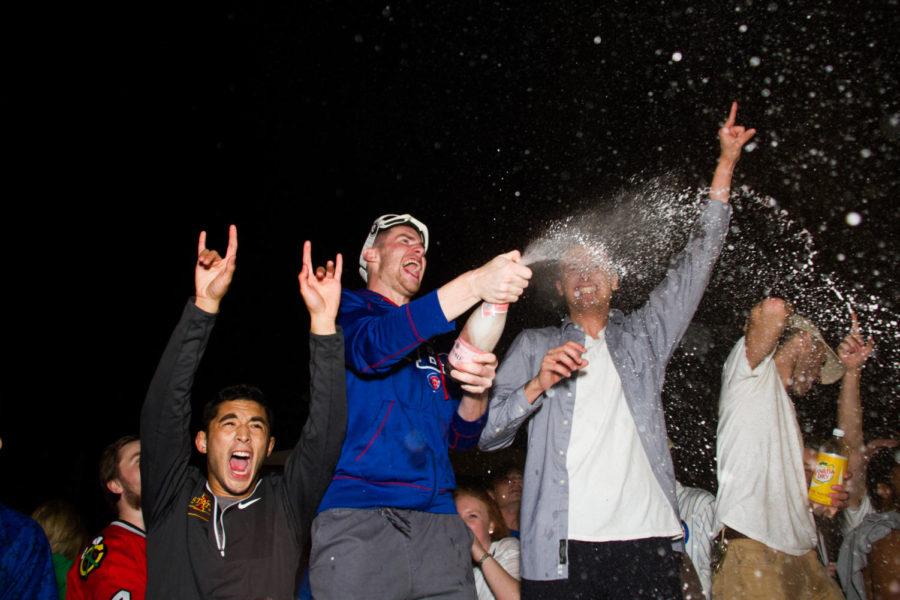Wasted Away: The culture of alcohol at Iowa State
Chicago Cubs fans take to the streets of Campustown to celebrate the Cubs’ World Series win, during the early morning of Nov. 3.
August 20, 2017
Alcohol has an effect on many college campuses — Iowa State is not immune. Before students even step foot on Iowa State’s campus, they take AlcoholEdu, meant to help educate them about safe drinking habits. During students’ time at school, underage or not, alcohol may very likely be a part of their experience.
‘Wasted Away: The culture of alcohol at Iowa State’, which is a collaborative project between the Greenlee School of Journalism depth reporting class and the Iowa State Daily, explores what that experience looks like — good, bad or otherwise — and analyzes how it can affect other aspects of their lives.
At a glance
For many Iowa State students, Lincoln Way serves as a divide. The same highway that once stretched from Times Square in New York City to San Francisco in California carves Ames, Iowa, neatly in two.
On one side is campus: A place for education, growth and prosperity. With an enrollment of almost 40,000 students, it’s the largest in the state.
On the other: An accessible nightlife, alcohol on every corner and curb – fellow drunken kids celebrate in the wealth of their inebriation. Groups of people stand outside bars and clubs, talking loudly with driver’s licenses in hand, eager to get inside for a drink. Groups of people stumble out, talking louder than those waiting, and zig-zag their way across the street to the next bar.
Related content: The Veishea Void and Alcohol in the Greek Community
What is Iowa State doing?
Iowa State’s sole online alcohol education program – taken once before your freshman year – just wasn’t cutting it.
In 2005, a student killed another student by drunk driving. Two years later, a student was last seen leaving a party alone after a night of drinking, and his body was found at the bottom of Lake Laverne. In 2010, a student was hit by a train and killed on her way home from a bar. And just last year, a student who had been drinking fell from the roof of a sorority house and was paralyzed.
Related content: Getting help
A Vulnerable Brain
With drink specials available on Wednesday and Thursday nights along with the popularity of consuming alcohol on Friday and Saturday, the opportunity exists for students to enter into a behavior pattern with alcohol that could have negative consequences. Binge drinking five or more times a month is considered heavy alcohol use by the Substance Abuse and Mental Health Services Administration. It is this pattern of heavy alcohol use that can lead to negative consequences for long term health.
“When you go to a party or two, that is one thing, but going to a party every weekend during your four years of college, that is a different story, and now you are talking more about the continued exposure to relatively large amounts of the substance that will have a consequence later in life,” Acerbo said.
Jake’s Story
Jake walks alone through Iowa State’s dark campus, heading south toward Welch Avenue. From his apartment a few blocks north of campus, it’s quite the trip. He would drive, but he hasn’t had a valid license since his OWI last summer.
So he walks.
Finally, he reaches his destination. The fluorescent lights of the Kum & Go store welcome him inside like a familiar friend. Brushing past the aisles lined with snacks and various toiletry items, he approaches the refrigerated section.
As he’s done every other night this week, he grabs a six-pack of beer — plus a couple single cans for good measure — pays the cashier and starts the trek back home.
Half an hour later, he’s sitting in front of the TV in his apartment, the beers beside him. For the rest of the night, he sits there and drinks, gulping down each beer until there’s nothing left.
He has to finish them tonight. Leaving alcohol sitting around would pose a temptation he may not be able to resist before class the next morning.
By drinking it all tonight, he also gives himself a chance at a fresh start.
Maybe I won’t drink tomorrow, but if I have a bottle sitting here, I probably will.
Swallowing the last drops of liquid, he goes to bed, hoping maybe tomorrow will be different.
The next day, the pattern starts over again.
At 24 years old, Jake is an alcoholic.
Alcohol arrests
By the numbers:
Of the 1,298 cases Iowa State Police handled in 2016, 38 percent were alcohol-related.
- 138 operating while intoxicated arrests
- September (18 arrests) and July (17 arrests) were the most popular months
- 179 public intoxication arrests
- September (42 arrests) and October (26 arrests) were the most popular months
- 172 alcohol violations
- September (68 arrests) and October (38 arrests) were the most popular months
Related content: Effects on Employment







